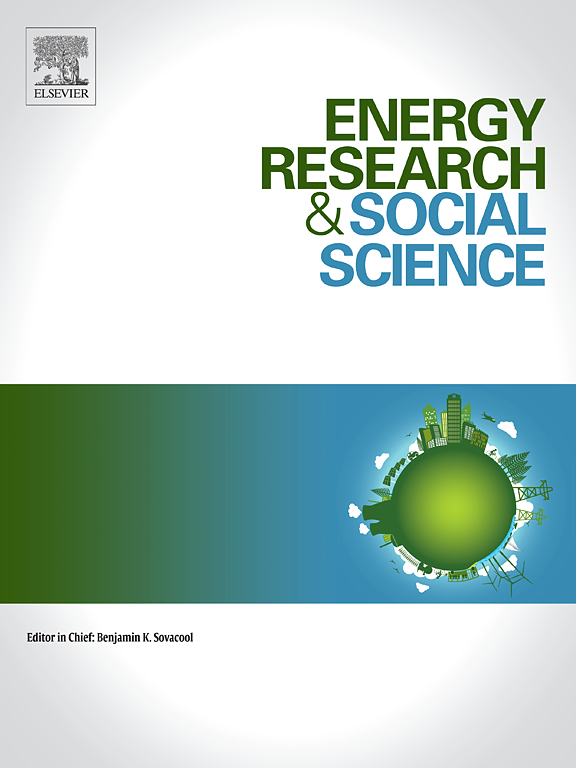欧盟的能源脆弱性:将热不适与适应能力联系起来
IF 7.4
2区 经济学
Q1 ENVIRONMENTAL STUDIES
引用次数: 0
摘要
能源贫困仍然是整个欧盟面临的紧迫挑战,受到结构、社会经济和行为因素的影响。随着气候变化的加剧,不仅要减少现有的能源贫困,而且要防止家庭容易受到这种贫困的影响。目前的评估往往依赖于狭隘的技术措施,忽视了建筑效率低下与家庭适应热不适的能力之间的相互作用。这项研究提出了一个多维能源脆弱性指数,使用统一的和公开的数据。该指数整合了两个维度:反映热不适暴露的建筑能源性能差距指数和结合社会经济和行为因素的适应能力指数。行为维度,如数字素养和感知自我效能,捕捉了很少在区域尺度上运作的适应能力方面。将该指数应用于整个欧洲宏观区域,揭示了巨大的空间差异:当适应热不适的社会经济和行为能力较弱时,建筑性能水平相似的地区仍然会经历高能源脆弱性。我们进一步表明,这些因素之间的相互作用在农村和城市背景下有所不同。这些发现突出了仅仅依靠技术性能指标来评估能源脆弱性的局限性。我们的框架为政策制定者提供了一个实用的工具,用于确定行动重点和设计针对区域情况的干预措施,从而在面对气候变化时提高结构效率和家庭适应能力。本文章由计算机程序翻译,如有差异,请以英文原文为准。
Unpacking energy vulnerability in the European Union: Linking thermal discomfort with adaptive capacity
Energy poverty remains a pressing challenge across the European Union, shaped by structural, socioeconomic, and behavioural factors. As climate change intensifies, it is essential not only to reduce existing energy poverty but also to prevent households from becoming vulnerable to it. Current assessments often rely on narrow technical measures, overlooking how building inefficiencies interact with households' ability to adapt to thermal discomfort. This study proposes a multidimensional Energy Vulnerability Index, using harmonised and publicly available data. The index integrates two dimensions: a building energy performance gap index, reflecting exposure to thermal discomfort, and an adaptive capacity index, which combines socioeconomic and behavioural factors. Behavioural dimensions such as digital literacy and perceived self-efficacy capture aspects of adaptive capacity rarely operationalised at regional scale. Applying the index across Europe's macro regions reveals substantial spatial variation: regions with similar levels of building performance can still experience high energy vulnerability when socioeconomic and behavioural capacities to adapt to thermal discomfort are weak. We further show that the interaction between these factors varies across rural and urban contexts. These findings highlight the limitations of relying solely on technical performance metrics to assess energy vulnerability. Our framework provides policymakers with a practical tool for identifying action priorities and designing interventions that are targeted to regional conditions, strengthening both structural efficiency and households' adaptive capacity in the face of climate change.
求助全文
通过发布文献求助,成功后即可免费获取论文全文。
去求助
来源期刊

Energy Research & Social Science
ENVIRONMENTAL STUDIES-
CiteScore
14.00
自引率
16.40%
发文量
441
审稿时长
55 days
期刊介绍:
Energy Research & Social Science (ERSS) is a peer-reviewed international journal that publishes original research and review articles examining the relationship between energy systems and society. ERSS covers a range of topics revolving around the intersection of energy technologies, fuels, and resources on one side and social processes and influences - including communities of energy users, people affected by energy production, social institutions, customs, traditions, behaviors, and policies - on the other. Put another way, ERSS investigates the social system surrounding energy technology and hardware. ERSS is relevant for energy practitioners, researchers interested in the social aspects of energy production or use, and policymakers.
Energy Research & Social Science (ERSS) provides an interdisciplinary forum to discuss how social and technical issues related to energy production and consumption interact. Energy production, distribution, and consumption all have both technical and human components, and the latter involves the human causes and consequences of energy-related activities and processes as well as social structures that shape how people interact with energy systems. Energy analysis, therefore, needs to look beyond the dimensions of technology and economics to include these social and human elements.
 求助内容:
求助内容: 应助结果提醒方式:
应助结果提醒方式:


